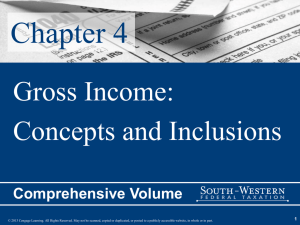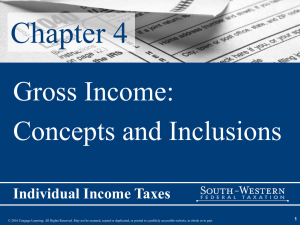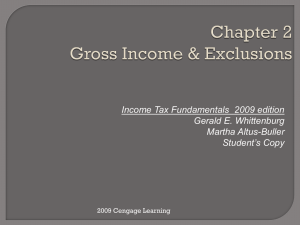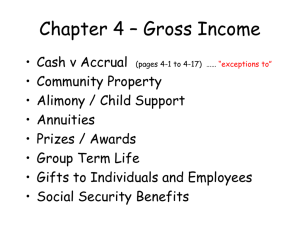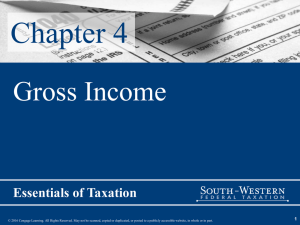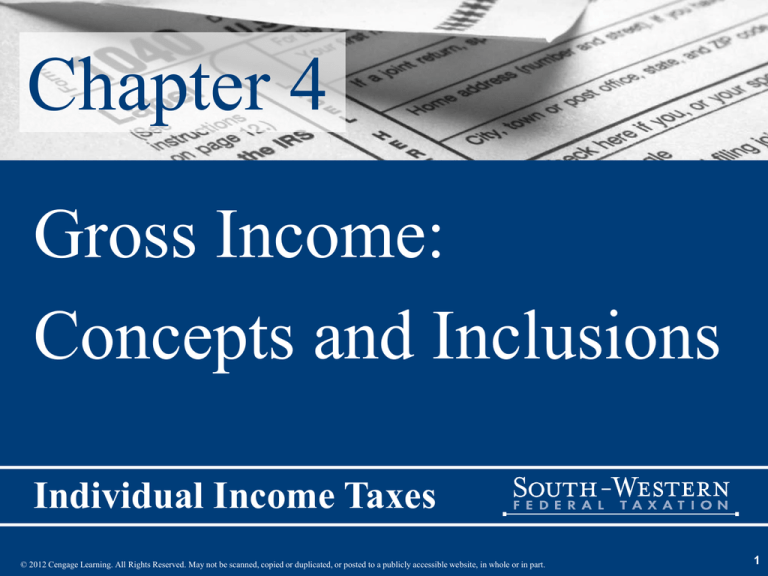
Chapter 4
Gross Income:
Concepts and Inclusions
Individual Income Taxes
© 2012 Cengage Learning. All Rights Reserved. May not be scanned, copied or duplicated, or posted to a publicly accessible website, in whole or in part.
1
The Big Picture
Calculation Of Gross Income (slide 1 of 3)
• At the beginning of the year, Dr. Cliff Payne opened
his dental practice as a sole proprietorship.
• For his new business, he selected a December 31
year-end.
• He also entered into a contract to have a building
constructed for his medical practice.
• He used $12,000 of extra money to purchase some
stock.
2
The Big Picture
Calculation Of Gross Income (slide 2 of 3)
• Dr. Payne’s accounting system provides him with the
following info regarding the income from his dental practice
for the 1st year of operation.
Revenues (amounts billed patients for dental services)
Accounts receivable: January 1
Accounts receivable: December 31
$385,000
–0–
52,000
• The accounts receivable represent amounts billed patients that
will be paid by patients, insurance companies, or charged off
as uncollectible bad debts.
• During the year, Sam Jones, a contractor who owed Dr. Payne
$4,000 for dental services, satisfied the account by installing
solar panels on the roof of Dr. Payne’s new medical building.
3
The Big Picture
Calculation Of Gross Income (slide 3 of 3)
• Based on his accounting records he concludes
that gross income for Federal income tax
purposes is the $385,000 he billed his patients
for dental services rendered.
• Has Dr. Payne correctly calculated the gross
income of this dental practice?
– Read the chapter and formulate your response.
4
Gross Income (slide 1 of 3)
• Definition: Gross income includes all income
from whatever source derived, unless
specifically excluded under the Code
• Concept is interpreted broadly by the courts
5
Gross Income (slide 2 of 3)
• Taxability of income follows the realization
principle from accounting
– Income is recognized (taxed) when realized
• Mere appreciation in wealth (economic
income) is not considered realized income
6
Gross Income (slide 3 of 3)
• Income is recognized whether it is in the form
of cash, or “in-kind” cash equivalents (i.e.,
property or services)
– The amount of income from “in-kind” receipts is
equal to the FMV of the property or services
• Income does not include recovery of the
taxpayer’s capital investment
7
The Big Picture - Example 1
Recovery Of Capital Doctrine
• Return to the facts of The Big Picture on p. 4-2.
– Dr. Payne sells common stock for $15,000.
• He had purchased the stock for $12,000.
– Dr. Payne’s gross receipts are $15,000.
• This amount consists of a $12,000 recovery of capital
and $3,000 of gross income.
8
The Big Picture - Example 5
Form Of Receipt
• Return to the facts of The Big Picture on p. 4-2.
– When Sam Jones performed the services in
satisfaction of his $4,000 account, Dr. Payne
realized income equal to the value of the services
of $4,000.
9
Accounting Periods
• Taxable year is generally a 12-month period
– Taxable year for most individual taxpayers is the
calendar year
– Fiscal year can be elected if taxpayer maintains
adequate records
• Fiscal year is a 12-month period ending on the last day
of a month other than December
– Example: July 1 to June 30
10
Accounting Methods (slide 1 of 2)
• There are 3 primary methods of accounting for
tax purposes:
– Cash receipts and disbursements method
– Accrual method
– Hybrid method
11
Accounting Methods (slide 2 of 2)
• In addition to overall accounting methods,
taxpayers may choose (elect) tax treatment for
various transactions, for example
– Taxpayers can elect to use the installment method
– Certain contractors may elect to use either the
percentage of completion method or the completed
contract method
12
Cash Receipts Method
• Income is recognized in the year it is actually
or constructively received in cash or cash
equivalent
• An amount is constructively received when it
is set aside and made available to taxpayer
without substantial restrictions
13
The Big Picture - Example 10
Constructive Receipt (slide 1 of 2)
• Return to the facts of The Big Picture on p. 4-2.
– On December 31, Dr. Payne has $10,000 in
patients' checks that have not been deposited.
• One check for $3,000 is from a patient who asked him
not to deposit it until after January 4th , because her
account did not contain sufficient funds to pay the debt.
14
The Big Picture - Example 10
Constructive Receipt (slide 2 of 2)
• Under the cash method, Dr. Payne must recognize
$7,000 income from the checks on hand
– The checks are a cash equivalent that is actually received.
• The income from the $3,000 check is neither actually
nor constructively received
– An insufficient account means the funds are not available.
15
The Big Picture - Example 12
Constructive Receipt (slide 1 of 2)
• Return to the facts of The Big Picture on p. 4-2.
• Assume Dr. Payne elected to use the cash basis of
accounting.
– If he accepted credit cards, Dr. Payne would receive
immediate credit in his bank account for 96% of the charge.
• The other 4% would be retained by the credit card issuer.
– To avoid the 4% charge, Dr. Payne chose not to accept
credit cards.
• Instead, his policy required all bills to be paid within 30 days after
dental services were provided.
16
The Big Picture - Example 12
Constructive Receipt (slide 2 of 2)
• At year end, several patients owed a combined
$2,000.
– They offered to pay with credit cards, but his
office rejected their offers.
– The $2,000 was not constructively received at the
end of the year.
• Dr. Payne could have received payment by credit card,
he contracted to receive payment at a later date before
the dental services were performed.
• Moreover, the 4% charge by the credit card company
would be a ‘‘substantial limitation.’’
17
Exceptions To Cash
Receipts Method
• Original Issue Discount (OID) interest is
taxable when earned rather than when interest
is received
• Series E and EE bonds are not subject to the
OID rules
– However, a cash basis taxpayer may elect to
recognize the interest when earned
18
Accrual Method (slide 1 of 2)
• Income is recognized in the year that it is earned
regardless of when it is collected
• Income is earned when:
– All events have occurred that fix taxpayer’s right to the
income, and
– The amount can be determined with reasonable accuracy
• The accrual method is required for determining
purchases and sales when inventory is an incomeproducing factor
19
Accrual Method (slide 2 of 2)
• Claim of right doctrine
– Requires amounts received to be included in
income even though the amount is in dispute and
might be returned to the payor at a later date
– If payment has not been received, no income is
recognized until the claim is settled
20
The Big Picture - Example 7
Claim Of Right Doctrine
• Return to the facts of The Big Picture on p. 4-2.
• On completing construction of the medical office
building in 2011, the contractor submitted a bill.
– Dr. Payne refused to pay the bill, claiming the contractor
had not met specifications.
– The contractor did not reach a settlement with Dr. Payne
until 2012.
• No income accrues to the contractor until 2012.
– If Dr. Payne had paid for the work, then filed suit, the
contractor could not defer the income
• The income would be taxable in 2011.
21
Exceptions to Accrual Method
(slide 1 of 2)
• Taxpayer can elect to defer recognition of
income from advance payment for goods if
same method of accounting is used for tax and
financial reporting purposes
22
Exceptions to Accrual Method
(slide 2 of 2)
• Advance payment for services to be performed
after year-end is included in income in the year
following receipt
– The portion of the advance payment that is earned
in the current year is included in income in the
year of receipt
• Prepaid rents or interest income are always
recognized in the year received rather than
when earned
23
Hybrid Method
• A combination of cash and accrual methods
• Generally, used when inventory is a material
income-producing factor
– Use accrual method to account for inventory
– Use cash method for other income and expenses
24
Income Sources (slide 1 of 2)
• Income from personal services is taxable to the
person who performs the services
– Fruit and tree metaphor
• Income from property is taxable to the owner
of the property
– Assignment of income is not permitted
25
Income Sources (slide 2 of 2)
• Interest income accrues daily
– If interest bearing instrument (e.g., bonds) is
transferred, must allocate interest income between
transferor and transferee based on the number of
days during the period that each owned the
property
26
Dividends (slide 1 of 4)
• Dividends are generally taxed to the party who
is entitled to receive them
– Dividends on stock transferred by gift after
declaration date but before record date is generally
taxed to the donor
27
Dividends (slide 2 of 4)
• Recent legislation has provided partial relief
from double taxation of corporate dividends
– Generally, dividends received in taxable years
beginning after 2002 are taxed at the same
marginal rate that is applicable to a net capital gain
• Thus, individuals otherwise subject to the 10% or 15%
marginal tax rates in 2011 pay 0% tax on qualified
dividends received
• Individuals subject to the 25, 28, 33, or 35 percent
marginal tax rates pay a 15% tax on qualified dividends
28
Dividends (slide 3 of 4)
• The following dividends are not eligible for
the reduced tax rates
– Dividends from certain foreign corporations,
– Dividends from tax-exempt entities, and
– Dividends that do not satisfy the holding period
requirement
• Stock on which the dividend is paid must have been
held for more than 60 days during the 121-day period
beginning 60 days before the ex-dividend date to qualify
for the reduced tax rates
29
Dividends (slide 4 of 4)
• Dividends from foreign corporations are
eligible for qualified dividend status only if:
– The foreign corporation’s stock is traded on an
established U.S. securities market, or
– The foreign corporation is eligible for the benefits
of a comprehensive income tax treaty between its
country of incorporation and the United States
30
Income Received By An Agent
• Income received by the taxpayer’s agent is
considered to be received by the taxpayer
– A cash basis principal must recognize the income
at the time it is received by the agent
31
Income From Partnerships
• A partnership is not a separate taxable entity
– Files an information return (Form 1065)
• Provides data necessary for determining each partner’s
distributive share of partnership’s income and
deductions
• Each partner reports distributive share of partnership
income and deductions
– Reported in year earned, even if not actually distributed
• Because a partner pays tax on income as the partnership
earns it, distributions are treated under the recovery of
capital rules
32
Income From S Corporations
• A small business corporation may elect to be
taxed similarly to a partnership
– Referred to as an S corporation
• The shareholders, rather than the corporation, pay the
tax on the corporation’s income
• Generally, shareholders report their share of the corp’s
income and deductions for the year, even if not actually
distributed
33
Income From Estates And Trusts
• Beneficiaries of estates and trusts
– Generally, taxed on the income earned by the
estates or trusts that is actually distributed or
required to be distributed to them
– Any income not taxed to the beneficiaries is
taxable to the estate or trust
34
Income In Community
Property States
• All property is deemed either to be separately owned
by the spouse or to belong to the marital community
– Community income is allocable equally to each spouse
– Separate income may be allocable to owner-spouse
• Separate property may produce community income
(e.g., TX, LA)
• No allocation of community income for some spouses
living apart for entire year and filing separately
35
Alimony and Separate Maintenance
Payments (slide 1 of 4)
• Alimony is:
– Deductible by payor
– Includible in gross income of recipient
36
Alimony and Separate Maintenance
Payments (slide 2 of 4)
• Payments may qualify as alimony if:
– Payments are in cash
– Agreement or decree does not specify that the
payments are not alimony
– Payor and payee are not members of the same
household at the time the payments are made
– There is no liability to make the payments for any
period after the death of the payee
37
Alimony and Separate Maintenance
Payments (slide 3 of 4)
• Property settlements
– Transfer of property to former spouse
– No deduction or recognized gain or loss for
transferor
– No gross income and carryover of transferor’s
basis for transferee
– Front-loading of alimony payments
• Alimony recapture (gross income) for payor
• Deduction from gross income for recipient
38
Alimony and Separate Maintenance
Payments (slide 4 of 4)
• Child support payments
– Payments made to satisfy legal obligation to support child
of taxpayer
– Nondeductible by payor and not taxed to recipient (or
child)
• May be difficult to determine whether an amount
received is alimony or child support
– If amount of payment would be reduced due to some future
event related to the child (e.g., child reaches age 21), such
reduction is deemed child support
39
Imputed Interest on Below-Market Loans
(slide 1 of 4)
• Interest is imputed, using Federal government rates,
when a loan does not carry a market rate of interest
– Imputed interest = the difference between the amount that
would have been charged at the Federal rate and the
amount actually charged
• Applies to:
•
•
•
•
Gift loans
Compensation-related loans
Corporate-shareholder loans
Tax avoidance loans
40
Imputed Interest on Below-Market Loans
(slide 2 of 4)
Concept Summary 4.2
41
Imputed Interest on Below-Market Loans
(slide 3 of 4)
• Gift loans
– Exemption for loans of ≤ $10,000 between
individuals
• If loan proceeds are used to purchase income-producing
property, the following limitation applies
– On loans of $100,000 or less between individuals
• Imputed interest is limited to borrower’s net investment
income for year
• No imputed interest if net investment income is $1,000
or less
42
Imputed Interest on Below-Market Loans
(slide 4 of 4)
• $10,000 exemption also applies to
compensation-related and corporationshareholder loans
– No exemption if principal purpose of loan is tax
avoidance
• Makes practically all loans of this type suspect
• Interest expense imputed to borrower may be
deductible
43
Annuity Income
(slide 1 of 6)
• Purchaser pays fixed amount for the right to
receive a future stream of payments
– Generally, early collections and loans against
annuity ≤ increases in cash value are included in
gross income
• Amounts > increases in cash value are treated as a
recovery of capital until cost recovered; additional
amounts are included in income
– Early distributions may also be subject to a 10%
penalty
44
Annuity Income
(slide 2 of 6)
• For collections on and after the annuity
starting date
– The exclusion ratio is applied to annuity
payments received under contract to determine
amount excludable:
Exclusion ratio =
Investment in contract
Expected return under contract
– Once investment is recovered, remaining
payments are taxable in full
45
Annuity Income
(slide 3 of 6)
• Examples:
– Taxpayer pays $10,000 for annuity that will pay
$1,000 a year
• A: For a term of 15 years
• B: For lifetime (life expectancy = 15 years)
– Exclusion ratio for A & B =
$10,000 = .667
$15,000
46
Annuity Income
(slide 4 of 6)
• Example (cont’d)
– A: 15 years of annuity payments
• Years 1-15: $333 taxable and $667 excludable
47
Annuity Income
(slide 5 of 6)
• Example (cont’d)
– B: Lifetime payments and taxpayer lives 18 years
• Years 1-15: $333 taxable and $667 excludable
• Years 16-18: $1,000 taxable
– B: Lifetime payments and taxpayer lives 10 years
• Years 1-10: $333 taxable and $667 excludable, and
$3,330 deduction on final return
48
Annuity Income
(slide 6 of 6)
• The simplified method is required for annuity
distributions from a qualified retirement plan
– Exclusion amount is investment in contract divided
by number of anticipated monthly payments (table
amount based on age)
49
Prizes and Awards
• General rule: FMV of item is included in
income
• Exceptions:
• Taxpayer designates qualified organization to receive
prize or award (subject to other requirements)
• Employee achievement awards of tangible personal
property made in recognition of length of service or
safety achievement (limits apply)
50
Group Term Life Insurance
• Exclude premiums paid by employer on first $50,000
of coverage
– Premiums on excess coverage are included in gross income
• Inclusion amount based on IRS provided tables
• If plan discriminates in favor of key employees (e.g.,
officers), key employees are not eligible for exclusion
– In such a case, the key employees must include in gross
income the greater of:
• The actual premiums paid by the employer, or
• The amount calculated from the Uniform Premiums table
51
Unemployment Compensation
• Unemployment compensation is taxable in full
– Under prior law (ARRTA of 2009) the first $2,400
of unemployment compensation was excluded
from gross income
• Congress chose not to extend this exclusion relief in
2010 tax legislation.
52
Social Security Benefits
(slide 1 of 6)
• Up to 85% of benefits may be taxable
• Taxability based on taxpayer’s modified
adjusted gross income (MAGI)
– MAGI = AGI (excluding Social Security) +
foreign earned income exclusion + tax exempt
interest
• Two formulas for computing taxable benefits
53
Social Security Benefits
(slide 2 of 6)
• Formula 1 - If MAGI plus ½ of Social Security
benefits exceeds the base amounts below, but not the
second set of base amounts,
– Include in income the lesser of:
• .50 (Social Security Benefits), or
• .50 [MAGI + .50 (SSB) - base amount]
–
–
–
–
Base amounts:
$32,000 MFJ,
$0 MFS and not living apart,
$25,000 for all other taxpayers
54
Social Security Benefits
(slide 3 of 6)
• Formula 2 - If MAGI plus ½ of Social Security
benefits exceeds the base amounts below
– Include in income the lesser of:
• .85(Social Security benefits), or
• Sum of: .85[MAGI + .50(Social Security benefits) - second base
amount], and the lesser of:
– Amount included through application of the first formula
– $4,500 ($6,000 for married filing jointly).
• Base amounts:
– $44,000 MFJ,
– $0 MFS and not living apart
– $34,000 for all other taxpayers
55
Social Security Benefits
(slide 4 of 6)
• Example of Social Security income:
– A: Married with AGI = $30,000; tax exempt
interest income = $3,000; Social Security benefits
= $10,000
– B: Married with AGI = $40,000; tax exempt
interest income = $6,000; Social Security benefits
= $10,000
56
Social Security Benefits
(slide 5 of 6)
• Example (cont’d)
– A: Formula 1: Lesser of:
• .50 ($10,000) = $5,000, or
• .50 [($30,000 + $3,000) + .50 ($10,000) - $32,000)] =
$3,000
• Therefore, $3,000 of Social Security benefits included
in gross income
57
Social Security Benefits
(slide 6 of 6)
• Example (cont’d)
– B: Formula 2: Lesser of:
• .85 ($10,000) = $8,500, or
• Sum of
– .85[($40,000 + $6,000) + .50 ($10,000) - $44,000] = $5,950,
and
– Lesser of:
– .50 ($10,000) = $5,000, or
– $6,000
• Therefore, $8,500 of Social Security benefits included
in gross income
58
Refocus On The Big Picture
• Using the accrual method of accounting, Dr.
Cliff Payne has correctly calculated the gross
income of his sole proprietorship.
– He will report the $385,000 amount on Schedule C
of Form 1040.
59
If you have any comments or suggestions concerning this
PowerPoint Presentation for South-Western Federal
Taxation, please contact:
Dr. Donald R. Trippeer, CPA
trippedr@oneonta.edu
SUNY Oneonta
60

